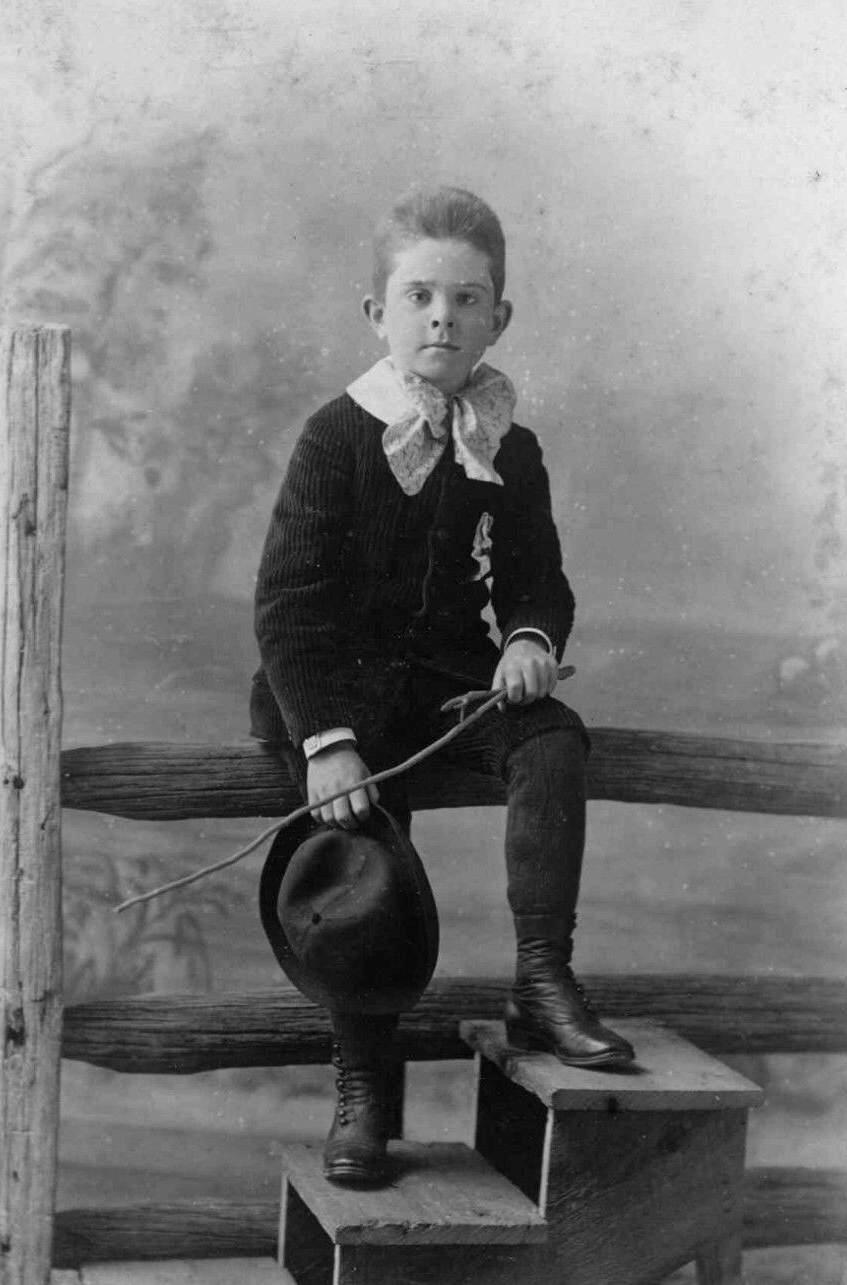
Corduroy Chronology: The 19th Century

Figure 1.--It is often not possible to identify corduroy or other fabrics in 19th century photography, especially theearly formats (Dags and Ambros). It is somewhat easier with CDVs and even more so cabinet cards. Thie unidentified boy in this cabinet card portrait clearly wears a corduroy knee pants suit. A dealer thinks he wore the outfit for horseback riding. We are not sure about this, but it is a possibility. Hard wearing cotdyroy may have been seen as suitable for horseback riding. The outfit and mount pinking here suggests the 1890s. The studio was A.G. Wheeler in Goshen N.Y. The dealer adds that it was an area know for horses.
|
|
We know little about corduroy in the early 19th century, in part because paintings rarely are detailed enough to reveal corduroy. There are, however, a range of written references. Corduroy by the 1820s (presumably even earlier) had become an important English export product. The English clergyman, Sydney Smith, complained in verse during a 1820 trade recession," No distant climes demand our corduroy, Unmatched habiliment for man and boy." The Scottish poet Thomas Aird describes a country boy who practices swiming on dry land, "unmindful how the grass/Or cloverleaves green-stain his corduroys". By the mid-19th century it was being worn by rural and working-class boys. English boys by the 1850s, probably earlier, were wearing cord garments. The popularity was limited to boys in rural areas and from working-class families. Posh parents at the time did not dress their boys in corduroy or wear the fabric themselves. Photography was invented (1839). Early photographs (Daguerreotypes and Ambrotypes) rarely are detailed enough to discern fabrics. This changed with the CDV and especially the caninet card which were not only done in much larger numbers, but are sometimes detailed enough to identify farics. And we note corduroy worn by boys who are not necessaeily working-class boys.
The 1820s
Corduroy by the 1820s (presumably even earlier) had become an important English export product. The English clergyman, Sydney Smith, complained in verse during a 1820 trade recession," No distant climes demand our corduroy, Unmatched habiliment for man and boy."
The 1840s
We do not yet have any photographic evidence of corduroy from the 1840s. Daguereotypes were rather small images and in many the photographic quality is not good. We can make out fashions, but fabric is another matter. We mave eventually find some, but we have not yet done so. Corduroy was, however a well established fabric and there is some considerable literary and other written evidence. The Scottish poet Thomas Aird describes a country boy who practices swiming on dry land, "unmindful how the grass/Or cloverleaves green-stain his corduroys". (A probem later for cricketers' white fannels.) Charles Dickens describes the cheeky schoolboy, Master Bailey in Martin Chuzzlewit (1844), who decrates his cords with charcoal scribbles. Thenotable German poet Heinrich Heine wrote around 1840 in one of his books that his father had been importing some textiles with the name Manchester. The family lived in Düsseldorf in the Rhineland. First the fabric was called velveteen, but the English name is of course corduroy, the Germans called it Manchester after the city in England where it was made.
The 1850s
English boys by the 1850s were commonly wearing cord garments. Cord seems to have been espcially popular with boys in rural areas and from urban working-class families. Posh parents at the time did not dress their boys in corduroy or wear the fabric themselves. Rural boys wore cord trousers and sometinmes jackets and waistcoats in the popular paintings of Thomas Webster, William Frith, Octavius Oakley, and others. Frith's famous "Derby Day" (1858) has a pair of corduroy-clad urchins swaggering in the center foreground and a fine pair of rustic cords is worn by the very pretty subject of John Brett's sparkling "Stone-Breaker" (1858). Writers like Dickens often reffered to corduroy when decribing the clothing of boys. He describes a school room in David Copperfield (1850) as smellng of "mildewed corduroy"
The 1880s
Sydney Webb decalred that "... corduroy has been relegated to the use of navvies and tramps."
The 1890s
We see American biys wearing corduroy suits in the 1890s. The unidentified New York boy here is a good example. We are not yet sure how popular cord suits were. Corduroy became very popular with the new German uniformed youth movement, the Wander Vogel. Hiking through the countryside was a favored activity of the Wandervogel and hardwearing corduroy was especially appreciated.
HB

Navigate the Boys' Historical Clothing Web Site casual pages:
[Return to the Main corduroy chronology page]
[Return to the Main fabric page page]
[Camp shorts]
[Clam diggers]
[Cord shorts]
[Jeans]
[Jump suits]
[Koveralls]
[Lederhosen]
[Pinafore]
[Shortalls]
[Smocks]
[Soccer shorts]
Navigate the Boys' Historical Clothing Web Site:
[Introduction]
[Activities]
[Biographies]
[Chronology]
[Clothing styles]
[Countries]
[Theatricals]
[Topics]
[Bibliographies]
[Contributions]
[FAQs]
[Glossaries]
[Images]
[Links]
[Registration]
[Tools]
[Boys' Clothing Home]
Created: 4:00 AM 3/1/2014
Last updated: 8:29 PM 3/1/2014



